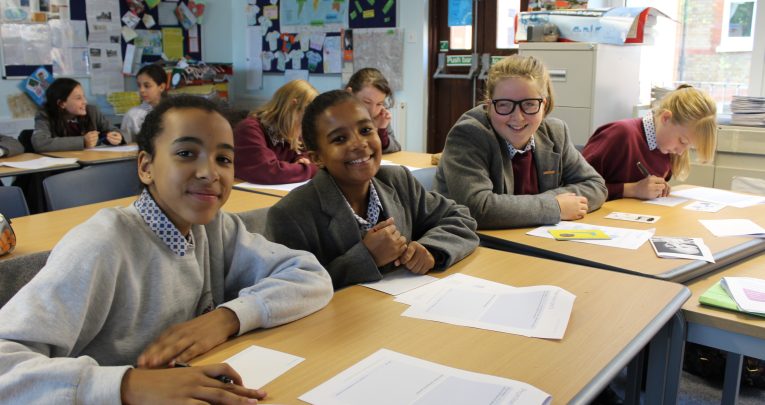5 Tips For Tackling Self-Esteem And Body Confidence in Schools

If you're planning to address self-esteem and body confidence topics as part of your school's PSHE provision, the materials available from the Dove Self-Esteem Project and 5 tips below should help get things off to a good start…

At the Dove Self-Esteem Project, we’ve been working since 2004 to support teachers tackling the topics of self-esteem and body confidence, and are delighted that the project has been able to impact on the lives of 2 million young people thus far.
The Dove Self-Esteem Project includes a free workshop tour for schools, where external facilitators deliver sessions for students aged 11 to 14. We also provide free online, curriculum-linked teaching resources that are accredited by the PSHE Association.
The workshop encourages young people to confront social pressures on body image and self-esteem, and help them realise how media can be manipulated to promote unrealistic ideals regarding people’s outward appearance.
5 Practical pointers
We’ve generally found students to be thoughtful and receptive wherever we go. However, there’s always more work to be done – so here we’ve put together five practical pointers for teachers to consider when planning lessons that address self-esteem and body confidence.
1. Check your school’s policies and procedures Before teaching a lesson on self-esteem, it’s important to check school policy and procedure. Familiarise yourself with this information, incorporate it into your lesson plan and provide students with relevant guidance.
It may be that the school has other initiatives which look at topics such as obesity and healthy eating running concurrently that might link with the issues tackled by the Dove Self-Esteem Project. It may also be that school procedure needs to be updated. Further guidance on policy and procedure can be found in the PSHE Association’s character education toolkit, which aims to support PSHE practitioners when integrating character education and is free to download for all PSHE Association members.
2. Set clear ground rules Clear, basic ground rules are an essential foundation for open discussions. Pupils will already know what is expected of them in the classroom, but re-iterating some fundamental ground rules will help the class feel safe and confident to join in. Avoid activities that ask pupils to discuss their own body shape or the appearance of others in the room; de-personalising the discussions and referring to ‘young people in general’ rather than someone in particular will relieve any pressure felt by individual students. Remember that weight stigmatisation affects those who both underweight and overweight, and is relevant for boys as well as girls.
3. Use external resources and imagery with care Images can convey a powerful message, but avoid using shocking images as this could have unintended consequences. Avoid depicting only one gender, body type, ethnicity or lifestyle – and also bear in mind that images of models and celebrities do not necessarily send a clear message.
External guests can provide a fresh voice, but it has been found that in the past, some external experts have inadvertently glamorised or ‘instructed’ on negative behaviours. For those trained to provide safe support, the PSHE Association recommends Dove Self-Esteem Project and Beat Ambassadors.
4. Offer a variety of activities It’s important that the session generates open conversation between students, while giving everybody a chance to contribute. Everyone is entitled to their own opinion – there are no right or wrong answers whilst dealing with such a subjective topic.
To get those conversations going, a variety of activities in differing group sizes could be beneficial, such as small team debates, and group research and presentation assignments.
In my experience, these sessions can be a great time to learn more about your class. Offering multiple conversational tools will ensure that everyone has a chance to take part, and it can be beneficial as the teacher/workshop leader to move around the groups and join in their conversations. After a workshop, it’s common to hear classes continue chatting about the issues as they leave – sometimes all the way down the corridor!
5. Talk to pupils beforehand, speak with parents afterwards It can be beneficial to include pupils when planning these lessons. Asking for anonymous suggestions from them as to what they would like to explore may highlight issues that might otherwise go overlooked, and we’ve found that this type of ‘pre-consultation’ can also help to engage them more during the session itself.
After the lesson, it’s really beneficial to share best practice with parents, who we’ve found are invariably keen to learn more. You might want to include a session on self-esteem in existing parent programmes, or share information via regular school communications. There is also an area for parents on the Dove Self-Esteem Project website that you can direct them towards for more information.
Rachel Timney is Workshop Tour Manager for the Dove Self-Esteem Project, which provides schools with free resources for running up to five class sessions on self-esteem and body confidence suitable for 11 to 14-year-olds. You can also sign up for a free visit from the Dove Self-Esteem Project UK workshop tour.
A Dove ‘Confident Me’ single-session workshop for KS3 learners is available to download from Teachwire’s resources section; For more information, visit the Dove Self-Esteem Project website











